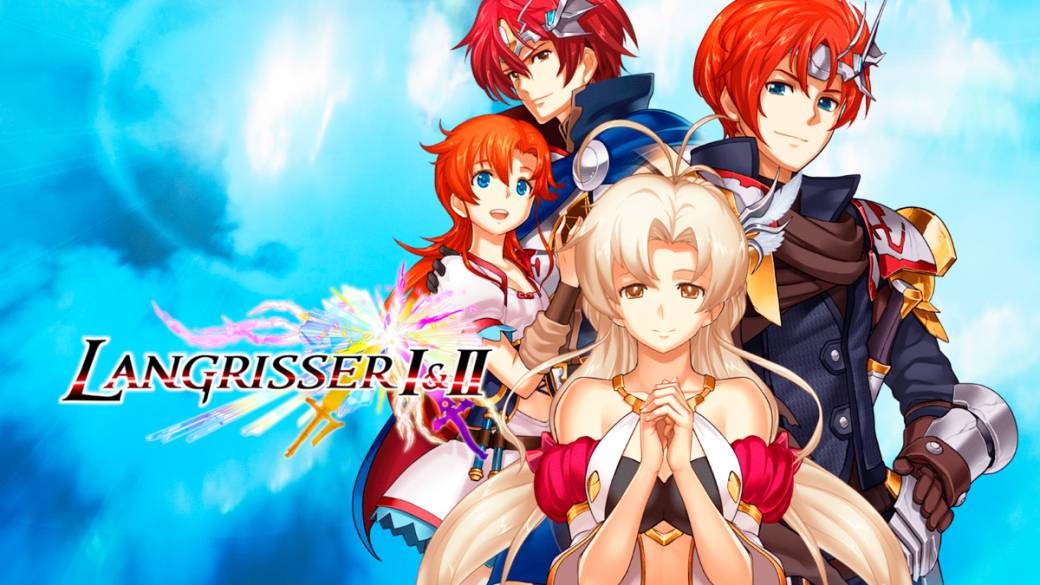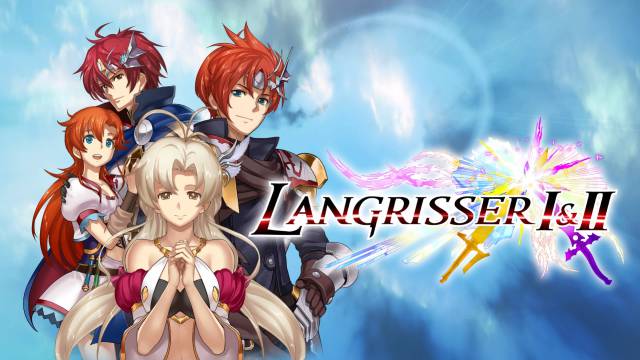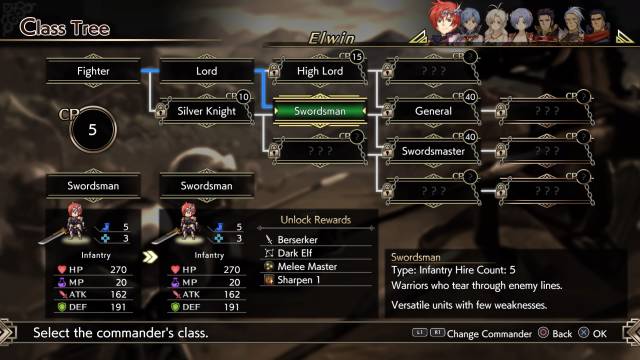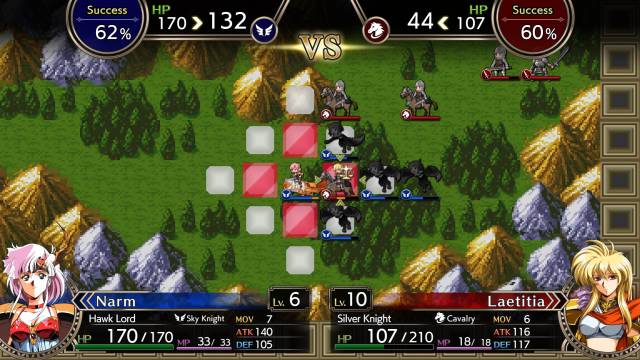
We analyze the compilation that includes the first two installments of the Langrisser series, an iconic saga of tactical RPG cut originating in the 90s.
The origins of the Langrisser series start in the early 1990s with the launch in Japan of the first game in 1991 for the Sega Mega Drive system, developed by Masaya Games. The game offered a tactical role-playing style that would rarely be seen in other titles of the genre, such as the immensity of the combat through the control of the units, in large numbers, of each of the confrontations that occur throughout the game. Along with the clashes between units, in addition to an interesting story and striking characters, the latter in part is due to the designs of the famous mangaka Satoshi Urushihara who would offer his work for this and the subsequent sequels that would see the light in later years. Also notable was the soundtrack whose composers included Noriyuki Iwadare, which some will recognize for their work on the titles of the Grandia and Lunar series.
In the West, the presence of the series has been testimonial and very scarce. In 1991 the conversion for the United States of the first game would be launched under the title of Warsong for the Sega Genesis with some changes in the design of the characters and names. The next game in the series to see the light would be Lagrisser Re: Incarnation Tensei for the Nintendo 3DS that would see the light in 2016. Today, almost 30 years after the launch of the original game, comes the compilation that includes the first two games of the series to present the saga and offer a classic tactical experience to current players.
From the start the game allows you to choose between both games to start playing, however it is convenient to start them in order since there are certain aspects that connect both titles with each other. When starting both games, the goddess Lucilis will appear, who will carry out a short test with various questions that will determine the stats of the protagonist of each game throughout the game. The first game begins with the siege of the kingdom of Baldia by the troops of the Empire of Darsis. In this situation King Illzach urges his son, Prince Ledin, to escape the castle along with the swordsman Volkoff, to ask the Duke of Hawking for help in providing reinforcements to deal with the threat. Despite getting the necessary help, Narm, one of the loyal warriors of the kingdom of Baldia, carries with her the news of the castle's fall. The situation will be complicated when they realize that the kingdom's treasure, the Langrisser sword, has been stolen and that the empire plans to unleash the power of darkness that remains sealed within to dominate the world. The second title is developed years later, being the protagonist of this installment Elwin, a young adventurer who travels with the sorcerer Heim. During their journey they receive news that the Raygard Empire is looking for a young priestess named Liana, who is in a nearby village, so both decide to rescue her at all costs before they are captured by the imperial troops. After achieving their goal, they decide to embark on a journey to protect Liana while discovering that the Empire's objective is to find two dark artifacts, the Alhazard sword and the dark scepter, in order to release the dark power sealed in the Langrisser sword. , who resides inside the castle of the kingdom of Baldia.
The development of each plot is carried out through several chapters in which a combat scenario will take place. The story is not told in the traditional way, although there are conversational sequences in much of the game, so you have to resort to listening to the synopsis prior to each phase in the game menu, pressing the square button, which will put the situation in the events between each chapter. Progress can be viewed in the Story Tree option, which shows a detailed diagram that will mark the current chapter that will take place next and those that are already passed, having the option to replay them losing the progress of the story but preserving the levels and equipment of the units. Also shown are the different routes that can be accessed, which require specific actions to be taken in certain chapters of the game and which will entail drastic changes in the development of the plot and the evolution of its characters, offering the first title a total of eight possible routes, while the second is a maximum of thirteen.

At the beginning of a combat scenario, each of the character units, called in-game commanders, will be recruited to mercenaries to fight as allies, which requires a good amount of gold. In principle, the types available in the game are reduced to infantry, spearmen and cavalry, having among them a stone-paper-scissors style system that defines the strengths and weaknesses of each one, similar to other sagas of the genre such as Fire Emblem. These conditions work in such a way that the infantry leads the lancers in combat, the lancers can easily defeat the cavalry and the latter do the same with the infantry. As the game progresses, new units can be unlocked, which will depend on the class of each character, and which will include stronger and more resistant versions of the aforementioned as well as others that include different types of archers, crossbows and witches that can launch attacks from a distance and have the advantage to shoot down air units, those of the marine type, among which are mermaids or lizardmen that have more strength in aquatic areas, and those of the aerial type that are not affected by terrain and include fairies, angels, harpies and griffins.
The development is carried out through the basic system of squares of the genre, in which each unit will have a movement limited to a number of them, marked with a delimited area of blue color, having to distribute each of the units on the ground, which depending on the geographical situation of the same can grant some benefits in combat but in turn also certain disadvantages, such as units that are in rocky areas such as mountains will enjoy an extra defense. When attacking other units there will be a clash between the two that will show the confrontation of the troops in such a way that the life points of each unit will be reduced until reaching zero, which will be defeated and disappear from combat. At this point it must be noted that the main units that are defeated, with the exception of Ledin and Elwin being the protagonists of each story and that if they are defeated will mean the end of the game, they will not be permanently lost in the game. On the other hand, in certain scenarios there will be additional units that will serve as a target to protect or temporary allies that will be controlled by the machine. In each phase certain objects can be obtained on the ground, marked as brightness in certain areas that will only be obtained once, while additional rewards will be obtained at the end of each scenario, both in the form of accessories or money from the NPCs of the game in certain phases as additional class points for the character that has made the most casualties during combat, which will in turn receive the name of MVP. Additionally, in the second game you can unlock secret phases by performing certain actions during the development of some scenarios.

Each character will have a personalized class tree in which the points obtained by leveling up or after becoming the best character in the phase (MVP) can be invested with, in order to choose new classes with which different improvements will be obtained. Time to fight, ranging from a blatant improvement in stats to unlocking new units, abilities, and even new spells. As you obtain others, these will be available for immediate selection while making it possible to use the unlocked resources, while some of them will require you to unlock other branches in order to access and equip them. In this regard it should be noted that some characters will have a maximum level class while others may have two as an option.
The menu between each phase will also give access to a store where you can buy equipment for each of the main units available and that will include both different types of weapons, armor and accessories that will provide certain stats improvements when equipping them or some advantage in combat. Throughout each chapter the objects that will be offered in the store will be of better quality and performance, but at the same time their price will be higher. Each character will be able to equip an item of each category in their inventory, in such a way that it will be necessary to find a suitable combination between them that allows obtaining an improvement in the stats necessary for each character, such as sorcerers whose main strength resides in the magic stat or warriors in attack stat.

At the end of the game obtaining one of the endings, the option to save the game will be offered while restarting again with several options to choose from. The first one allows you to continue playing, from the beginning, with the level, money and objects obtained in the normal way, while the second one allows you to enter the challenge mode, which offers the player to keep his improvements and equipment or start the game from scratch. Game in such a way that each turn made while playing will gradually strengthen the enemies, thus testing the player's skills in each combat with new challenges of greater difficulty.
It should be noted that in the game options menu you can customize the style when playing through various options. Initially, the character designs and maps will be seen with the designs remastered for the occasion, but it also offers the possibility of alternating with the character designs of Satoshi Usushihara used in the original games and also playing with maps of classic cut, which will show the style of which they displayed at the time in the era of 16-bit consoles. The only impediment, although not particularly serious, that this option has is that the ingame modeling of the characters will keep the remastered style when playing. Likewise, this option will be available for the soundtrack, being able to listen to both the updated versions of the themes and listen to the versions of the themes of the original titles.

Playable this title represents a return to the roots of the tactical genre with the particular style of squares that various titles in the 80s and 90s made fashion among players of the genre. His main point of interest resides in the control of the different units in combat, not only limited to the main characters but to the mercenaries who make the combat ominous and intense, especially when seeing clashes between units when attacking. The system of weaknesses and strengths allows you to take advantage of situations in combat to try to prevent the enemy from taking advantage of it while defeating it while taking it into account, which allows you to focus the use of each unit in an effective way. On the other hand, all units are important because sorcerer characters such as Chris or Jessica, despite their low resistance, are very suitable for magic both in healing tasks and to attack with elemental magic respectively. In summary, the game offers a game system that, while somewhat tedious and archaic compared to other games in the genre, ends up being an experience that can be used to great advantage both for its combats and for the development of the game. plot and characters.
Regarding the graphic section, the game offers a style with remastered 2D designs for the characters and mapped in their development. Although they are of a remarkable level in both sections, the main interest lies in the option of using the original designs of Satoshi Urushihara, which offer a striking style, with special attention to women, evoking the original era of the game to the Once reminiscent of classic anime series like Record of Lodoss War, which is a point in favor of this remastering.

As for the sound, it should be noted that the compositions offered by the game offer a wide variety of styles with rocky touches at certain times as others with a more techno style, some of them interesting to listen to and that leave their mark. The option to listen to the original tracks allows you to not only appreciate the sound differences between the two but also to delight in listening to the songs evoking the original sounds of the soundtrack as it sounded in the 90s. Regarding the voices, the game only includes dubbing in Japanese for both titles.
CONCLUSION
Langrisser I & II offers two titles that evoke the classic and vintage style of tactical RPGs of the 90s with a renewed style but preserving the game system of the series through the control of the units in the field by while the confrontations with the enemies become exciting. The ability to play using classic design and soundtrack styles complement a title that will delight fans of the genre and connoisseurs of the series. Its only flaws lie in the language of the texts, only in English, and in that it can be tedious at certain times.
THE BEST
- The game system is addictive, especially due to the different units to be controlled and the confrontations against enemy units.
- The development of both deliveries that offer two different stories, with certain points in common, as well as different routes and endings.
- The option to configure the game with the designs of Satoshi Urushihara together with the retro style for maps and soundtrack.
WORST
- Texts in English.
- It can be somewhat tedious in some phases.
Very good
Game with a remarkable finish that we will enjoy and remember. A good purchase, highly recommended for lovers of the genre. It is well cared for at all levels.
